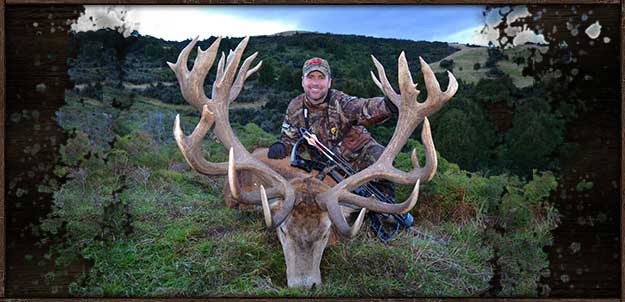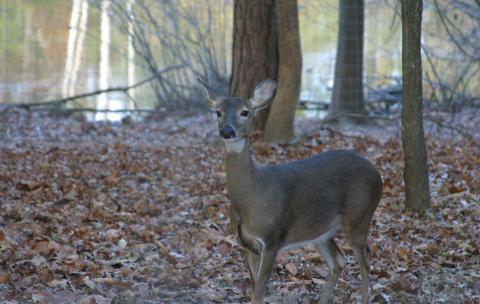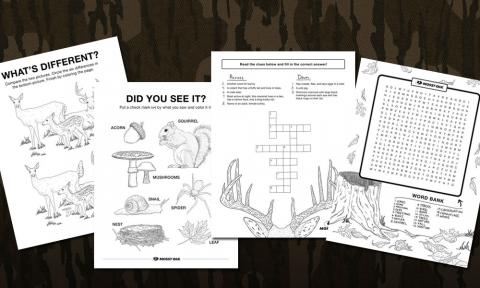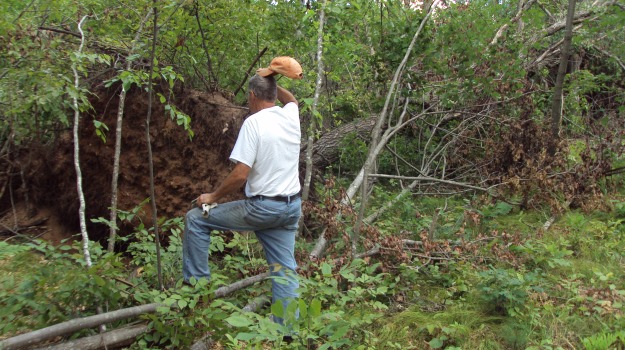
Hope for the Best, Plan for the Worst
By Marlene Odahlen-Hinz
We have been managing our Wisconsin property for wildlife for quite some time and have had a definite plan for improvements and projects we wanted to accomplish over both, the near and long term. Then on July 1st of last year a storm accompanied by 100 mph winds blew through and wreaked havoc on the property causing major damage to a 25 mile swatch of woodlands all around us. Like many landowners we didn’t have a plan to cope with the unpredicted devastation of our hunting property.
This unexpected storm changed the aesthetic value of the land as well as the habitat we’ve worked on for so long managing for wildlife. For some animals the storm created new habitat but for others, like deer, it dramatically changed their movement through the downed timber. Our main concern was that it would eliminate whitetail utilization all together. The area was “choked” with uprooted trees and heavy brush and we didn’t know how they would react.
Since our hunting property is located some distance from our residence it took us several days before we could make time to drive there in order to survey the damage. When we arrived we were overwhelmed as to the destructive blow Mother Nature had doled out. We began to ask ourselves some of the following questions.
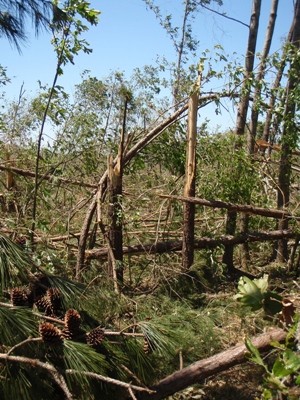 Where do you begin? The first thing to do is survey the property. We began our walkabout and started documenting the storm’s destruction on a notepad. It’s a good idea to make a simple map of the extent of the damage and the locations. We wanted to find out if the storm affected all the property or just a section? If only a small area was damaged you may be able to do the clean up yourself. If the destruction is more extensive you may need the help of professional loggers. It’s important to document the extent of the damage for insurance purposes. Be sure to bring a camera so the damage can be accurately recorded. If you don’t you may forget critical details when talking to your insurance agent.
Where do you begin? The first thing to do is survey the property. We began our walkabout and started documenting the storm’s destruction on a notepad. It’s a good idea to make a simple map of the extent of the damage and the locations. We wanted to find out if the storm affected all the property or just a section? If only a small area was damaged you may be able to do the clean up yourself. If the destruction is more extensive you may need the help of professional loggers. It’s important to document the extent of the damage for insurance purposes. Be sure to bring a camera so the damage can be accurately recorded. If you don’t you may forget critical details when talking to your insurance agent.
If you have any buildings on the property you will need to contact your home owner’s insurance agent. They will schedule a time when an appraiser can come to assess the damage done to those structures. I don’t know of any insurance company that would write a policy to insure timber. If they did the cost of the yearly premiums would soon eat up any profit you received when those trees were harvested. But any pole building, utility shed or hunting shack should be covered.
Do I need professional assistance? If the damage is extensive it’s a good idea to have it assessed by a forester. A forester can help you with any of the cutting requirements as well as the marketing of the salvaged timber. If your property has only scattered damage they can suggest if additional trees should be marked for harvest. Otherwise you can gas up that chain saw and next fall as you sit in front of a roaring fire you can see and feel the fruits of your labors.
Should the property be left as is? The answer is usually a resounding “no” even if you only own a very small parcel of land. As the downed timber dries, it becomes even more of a fire hazard. If a fire does occur, the fuel load from these trees and brush make a fire much more intense and extremely difficult to control.
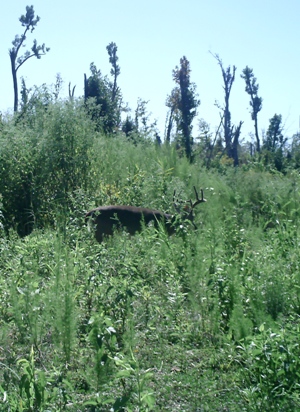 There are spots where you may want to leave specific spots that may have created ideal bedding sites or small thickets, but by not cleaning up your property you also lose income from salvaging the downed timber. Whatever money you can recoup could be used for future improvements.You may be able to deduct storm-damage losses on your income tax return so be sure to keep all receipts from expenses you’ve incurred and talk to your accountant regarding additional information they may need.
There are spots where you may want to leave specific spots that may have created ideal bedding sites or small thickets, but by not cleaning up your property you also lose income from salvaging the downed timber. Whatever money you can recoup could be used for future improvements.You may be able to deduct storm-damage losses on your income tax return so be sure to keep all receipts from expenses you’ve incurred and talk to your accountant regarding additional information they may need.
Harvesting the blown down timber will definitely encourage regeneration that will then help to draw and hold deer and other wildlife to your property. It is surprising how soon the new growth will start creating ample browse for the deer. Mother Nature can be amazingly quick about repairing her wounds.
How soon should clean up begin? The value of the downed timber deteriorates if you wait too long; so the sooner you can begin cleanup, the better. Here is where you can benefit from the assistance of a qualified forester so make an appointment for them to help make decisions. The consultant can not only lay out a plan for timber removal but also supervise the sale and marketing of it to insure maximum return to you. They can also give you the names of reliable loggers and inform you of regulatory requirements or permits.
What are the salvage guidelines? Broken, uprooted and bent trees are the types of damage you will have to deal with. Because of the internal tearing - bent, broken and splintered trees may not be suitable for lumber but can be used for pulp or particle board. So the most severely damaged timber should be salvaged first. It depends on the species of trees you have on your property and the product they will be used for as to the urgency of the salvage efforts.
Needle trees like white and red pine as well as tamarack dry out faster than leaf trees such as aspen and oak. White pine is the quickest to deteriorate. As it dries you will notice the first stage of the rotting process called blue stain. The wood can still be used for paper but it takes more bleach at the factory to make it usable thereby reducing the value.
Oak trees are the last to lose their value unless you have log or lumber quality trees. In that case the sooner you can harvest it the better. As with the softer woods, stain and boring insects degrade the lumber further reducing its market value.
Wood boring insects also reduce the value of the timber depending if they bore only under the bark or deeper into the trunk itself. They also leave a way for more decay to enter the wood even deeper. Since most boring insects are dormant or inactive during winter months you have until early spring before they begin to do significant damage to the trees if storm damage occurs in November and December.
If the trees are going to produce veneer, lumber or posts they should be harvested within 4-6 weeks after the storm occurred. Wood that will be made into pulp, fiber or particle board should be harvested within 8-12 months. Finally if firewood is the destination for the wood you have up to a year before the decay process begins to make it useless.
Is the wood any good? Much of the wood will be chipped or used as fuel. Pine trees that have been snapped off or uprooted and are laying flat on the ground can still be used for utility poles. If these pines remained standing but bent they may have compression fractures. These types of fractures are a gross defect for manufactures. However if you plan to use the wood yourself, it will add character and design to your finished project. A friend paneled his man cave with just such wood resulting in a surprisingly beautiful room.
A storm may only last minutes but the work required to restore your property can last months and even years. It’s heartbreaking not only to see the damage done by it, but also the bareness of the property remaining after the cleanup. However, it can create new opportunities for revitalizing your land. We chose to make lemonade out of the lemons that this storm gave us. We are now planning to put in two new food in spots that previously were difficult to get to. We hope they will create staging areas for the deer where they feel safe before heading out to surrounding alfalfa, corn and soy bean fields to feed at dusk. With easier access to the “back forty” we now can bring in heavier equipment in order to create a new source of water for the deer and other wildlife it will attract. We are now ready to roll up our sleeves since the shock of seeing the damage is over and we can almost taste the sweetness of the “lemonade” that awaits us.















